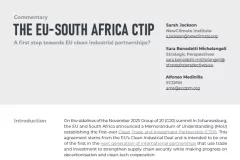By Sophie Boehm, Clea Schumer, Kelly Levin, Joel Jaeger, Judit Hecke, Danial Riaz, Raychel Santo, Katie Lebling, Anna Nilsson, Emily Daly, Marie-Charlotte Geffray, Neil Grant, Louise Jeffery and Michelle Sims
The UN’s most recent Emissions Gap Report issues a clear warning: Current policies and national climate commitments fall well short of what’s needed to rein in climate change.
Here’s the science: Limiting global temperature rise to 1.5 degrees C (2.7 degrees F) above pre-industrial levels is essential for avoiding increasingly severe and widespread climate change impacts, but doing so requires cutting greenhouse gas (GHG) emissions 42% by 2030 and 56% by 2035, relative to 2023. Current policies alone will achieve less than a 1% reduction by 2030 and 2035.
Closing these emissions gaps means deploying action at a pace and scale that are unprecedented. Unless countries can collectively and dramatically reduce GHG emissions by 2030, it will become impossible to make up enough lost ground by 2035 to limit warming to 1.5 degrees C with no or limited overshoot.
Fortunately, the year ahead presents a prime opportunity to shift the trajectory: Countries will put forward their next set of climate commitments, or nationally determined contributions (NDCs), by early 2025, detailing their intended climate actions over the next decade. Keeping the 1.5-degree C temperature goal within reach will require these next NDCs to achieve a “quantum leap in ambition” and deliver immediate action across all sectors of the economy.
What Are NDCs?
Countries are set to announce new NDCs under the Paris Agreement by early 2025. Updated every five years, these pledges underpin national climate action, outlining the mitigation and adaptation targets countries promise to achieve, as well as specific measures they plan to pursue. NDCs form the foundation of international efforts to combat the climate crisis.
But today’s commitments — even if fully implemented — put the world on course for 2.6-2.8 degrees C (4.7 to 5 degrees F) of warming and increasingly catastrophic impacts.
In this next round of NDCs, countries should set new economy-wide GHG emissions reductions targets for 2035 and stronger targets for 2030 that collectively put the world on track to limit temperature rise to 1.5 degrees C. Achieving these topline targets will require rapid, far-reaching changes across the economy. To help jumpstart them, countries should also include additional sector-specific targets within their NDCs. While most NDCs include pledges to reduce economy-wide GHG emissions, fewer have featured timebound, quantitative sector-specific goals.
So what exactly does that look like in terms of how we power our homes, grow our food, move people and goods, and more? Here, we break down the transformational changes needed in every sector of the economy to slash GHG emissions over the next decade.
Limiting Warming to 1.5 Degrees C: Sector-Specific Targets for 2030 and 2035
First and foremost, countries must strengthen their economy-wide GHG emissions reductions targets for 2030, as well as set new and ambitious targets for 2035, to get the world on track to limit warming to 1.5 degrees C. Going one step further to nest sector-specific targets under these topline, economy-wide targets – particularly those expressed in more concrete, real-world indicators like sales of electric vehicles or hectares of mangroves restored – can help make NDCs more actionable.
While many countries haven’t comprehensively included sector-specific targets in previous NDCs, doing so this time around can set clear benchmarks for both the public and private sectors. These targets, for example, can not only guide implementation across the whole of government, but also signal to companies and investors a country’s future direction.
To help inform this next round of NDCs, new research from Systems Change Lab translates the Paris Agreement’s 1.5 degrees C temperature goal into global, sector-specific targets for 2035, complementing previously published targets for 2030 and 2050.
Critically, countries do not need to progress at the same pace to collectively achieve these global sectoral goals. Developed countries have a responsibility to go furthest, fastest, and while other major emitters will also need to decarbonize rapidly, some may require finance and other support to do so. Still, these targets, alongside collective sectoral goals outlined within the Global Stocktake, offer a helpful starting point for countries as they develop their NDCs by specifying the pace and scale of transformational change needed across the most emissions-intensive sectors:
Power
Decarbonizing the power sector to help limit warming to 1.5 degrees C will require countries to rapidly transition away from fossil fuels in electricity generation, scale up zero-carbon sources like wind and solar, modernize power grids, expand energy storage, improve efficiency and better manage demand. To ensure a just low-carbon transition, countries should pair these mitigation measures alongside those that provide affordable, reliable and sustainable electricity for all.
Phasing out coal and unabated fossil gas is an immediate priority for the next generation of NDCs. For example, coal-fired power should see immediate and steep declines, with global shares in electricity generation falling 89% by 2030 and 97% by 2035 relative to today’s levels. The scale-up of renewables must also occur rapidly, both to replace these fossil fuels and to keep pace with growing demand. Our research shows the share of zero-carbon sources in electricity generation must increase 125%-133% by 2030 and 150% by 2035 from current levels. Wind and solar power, specifically, should account for the lion’s share of this growth.
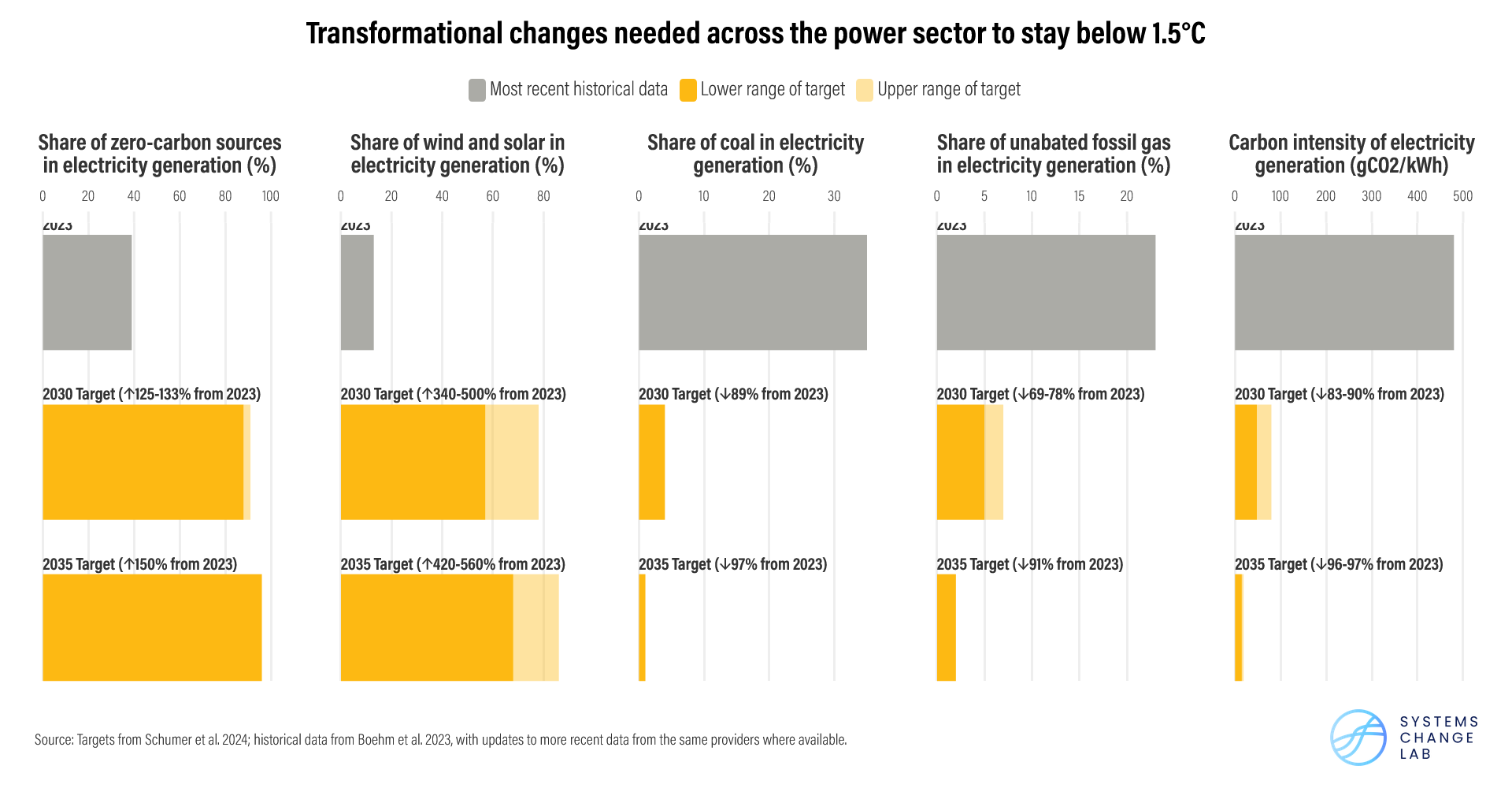
Buildings
Rapid reductions in GHG emissions across the buildings sector will require improving energy efficiency within buildings; decarbonizing the remaining energy used for heating, cooling and appliances; retrofitting existing buildings; and ensuring all new buildings’ operations are zero-carbon.
Buildings’ current levels of energy and carbon intensity must decline by 17%-41% and 58%-66%, respectively, by 2030. At the same time, annual retrofitting rates should increase by at least 150%-250% from recent levels to meet 2030 and 2035 targets, while today’s share of new buildings that are zero-carbon should grow by more than 1,000%.
Because built environments vary across countries, the mitigation targets nations opt to include within their NDCs may also differ. Some, for example, may choose to prioritize building retrofits that increase energy efficiency and reduce emissions, while those undergoing rapid urbanization may focus on ensuring that new buildings’ operations are zero-carbon.
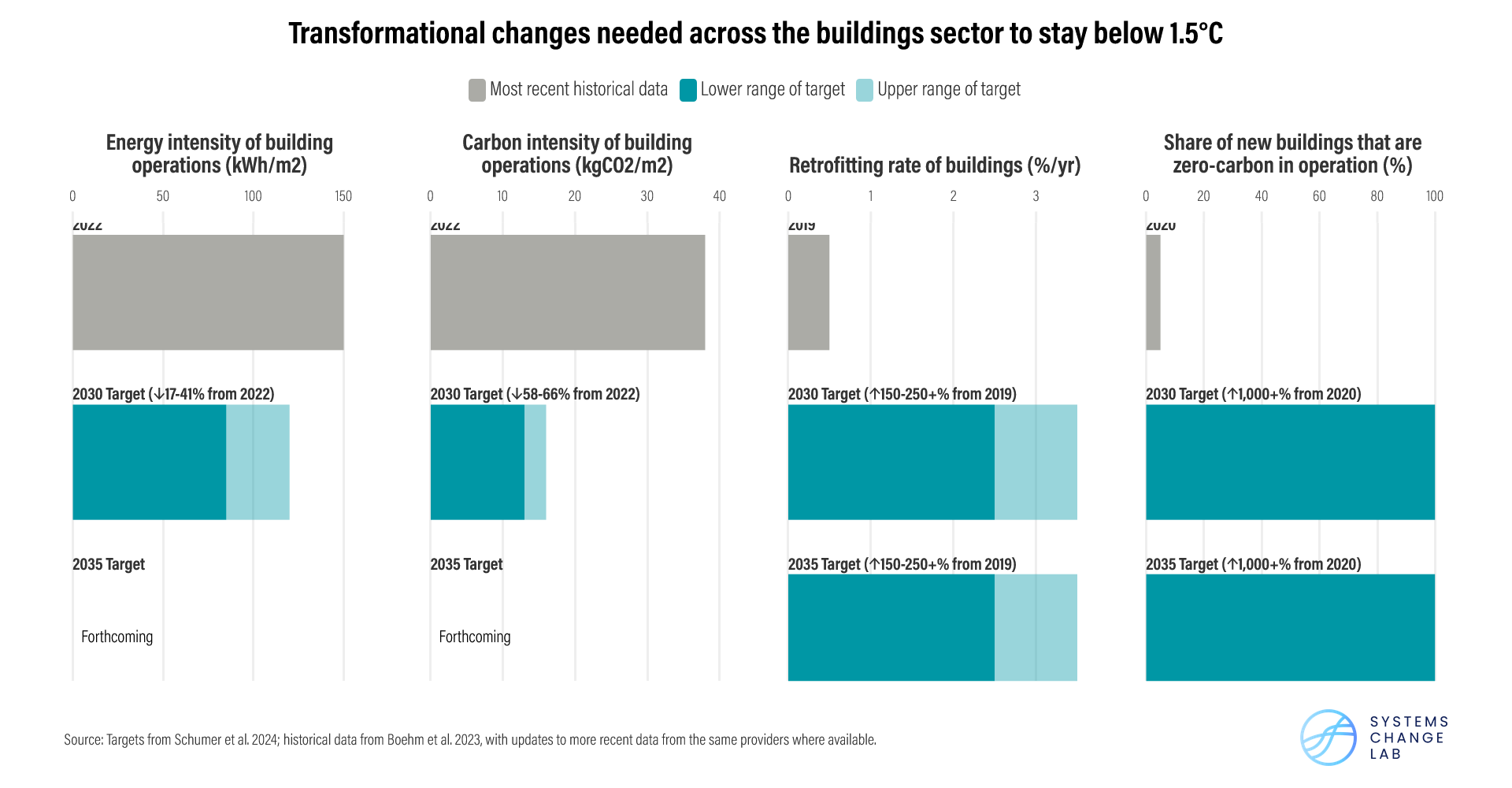
Industry
Lowering consumption through demand reduction and increased circularity; improving energy efficiency; electrifying industrial processes that rely on low- and medium-temperature heat; and developing new solutions like green hydrogen for those that cannot be easily electrified represent the most critical strategies for transforming the global industrial sector. Carbon capture and utilization and carbon capture and storage technologies can help mitigate remaining, harder-to-abate emissions from the sector.
As countries prepare their next NDCs, adopting targets focused on improving energy efficiency and electrifying low- and medium-temperature-heat industrial processes represents relatively low-hanging fruit. For example, the share of power coming from electricity instead of fossil fuels should increase 21%-48% in 2030 and 48%-59% in 2035, relative to today’s levels.
At the same time, countries must lay the groundwork for reducing harder-to-abate emissions, for example, by investing in research, development and deployment of alternative cement materials or green hydrogen to produce lower-carbon steel. Such innovations are critical for lowering the carbon intensity of cement and steel production, two of the highest-emitting industrial sub-sectors. Current levels of carbon intensity for both need to decline by relatively similar magnitudes by 2030 — upwards of 45% for cement and upwards of 30% for steel.
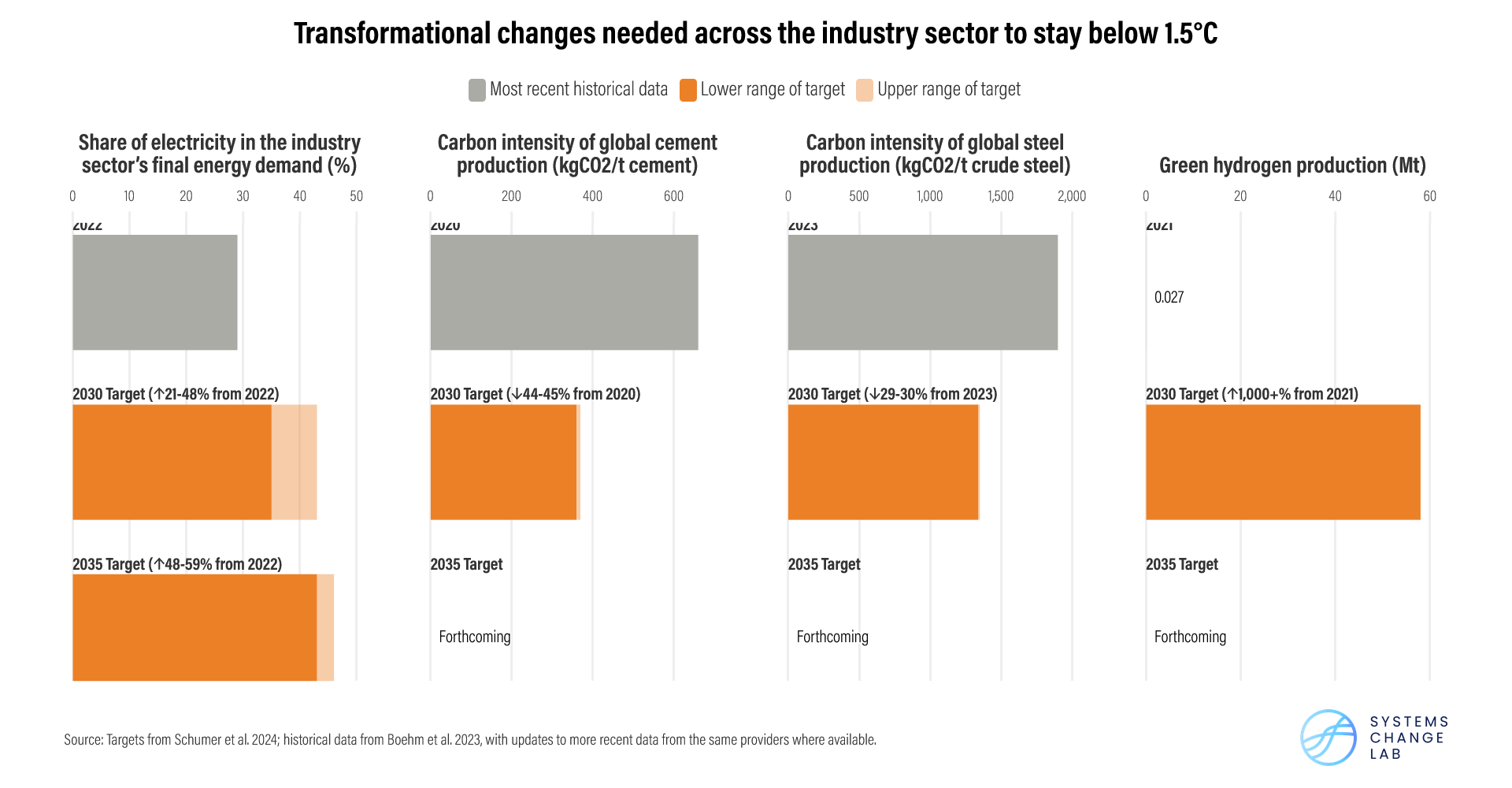
Transport
Reducing GHG emissions from transport will require a three-pronged “avoid-shift-improve" approach. First, bringing jobs, services and goods closer to where people live can help avoid some motorized transport. The world must also shift away from vehicle trips to public transportation, walking and cycling, while simultaneously improving existing modes by replacing internal combustion engines with electric cars, buses and trucks. Scaling sustainable and zero-emission fuel alternatives for aviation and shipping is also essential.
While unique country contexts will influence the transport targets that countries adopt in their NDCs, the scale of required changes globally are substantial across all prongs. For example, today’s rapid transit networks like metro rails, light-rail trains and bus lanes must expand by 90% by 2030. Electric vehicles’ current share of light-duty vehicle sales must increase by upwards of 690% by 2030 and 730% by 2035, while shares of sustainable aviation fuels and zero-emissions fuels in maritime shipping must both grow by more than 1,000% by 2030, relative to today’s levels.
Though the scale of change required is substantial, adoption of new zero-carbon technologies can occur rapidly, particularly when governments implement supportive policies. Already, some countries around the world are deploying these innovations at the global pace needed to limit warming to 1.5 degrees C.
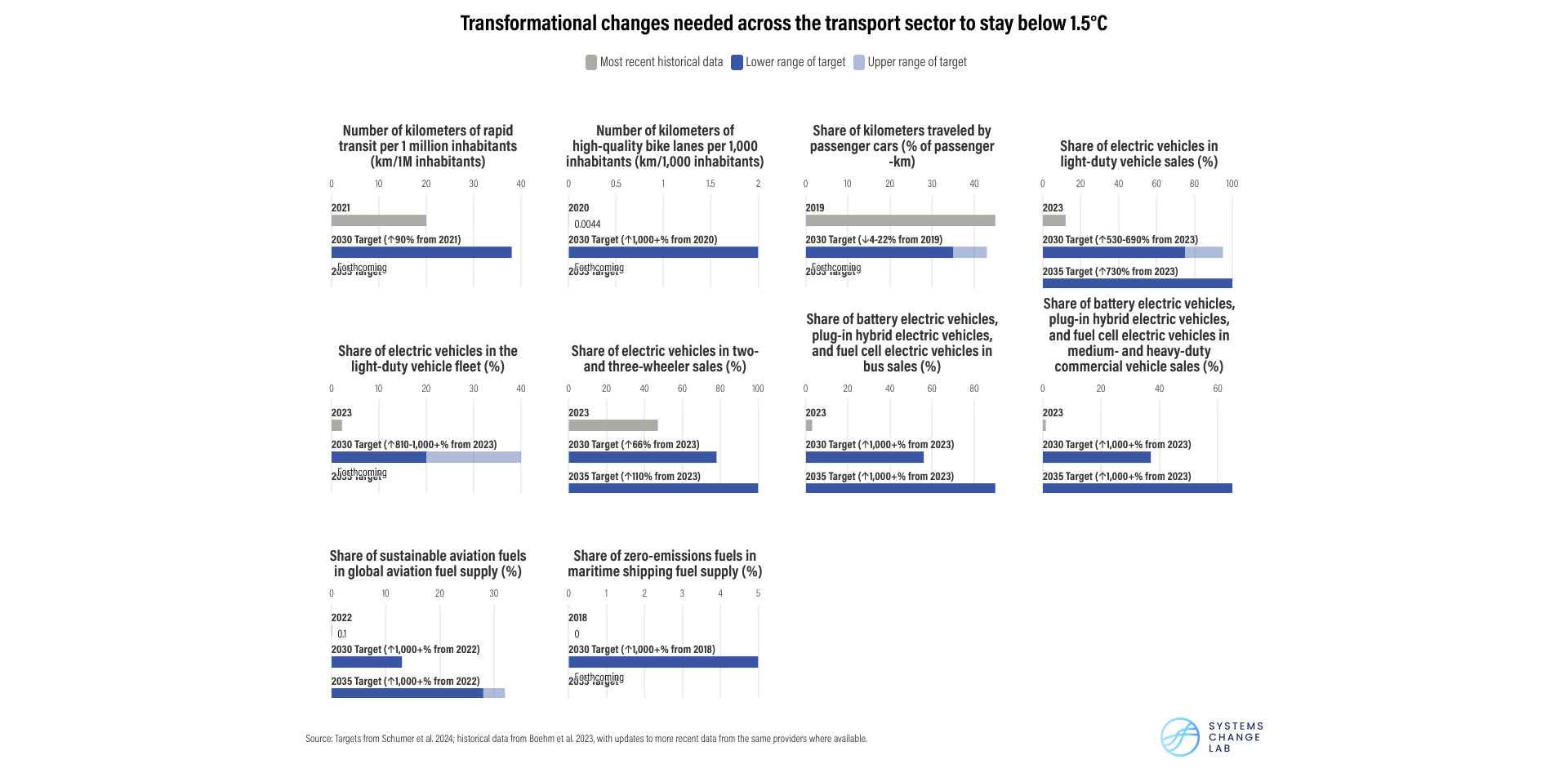
Forests and Land Use
Loss and degradation of the world’s ecosystems — particularly forests, peatlands, coastal wetlands and grasslands — release GHGs into the atmosphere, while protecting, restoring and sustainably managing these same ecosystems can lower GHG emissions and enhance carbon sequestration and storage. If implemented appropriately, these land-based mitigation measures can help limit warming while delivering substantial benefits for sustainable development, adaptation and biodiversity.
Among the most urgent priorities for this next round of NDCs is effectively halting deforestation and degradation of carbon-rich ecosystems. To limit warming to 1.5 degrees C, the annual rate of permanent forest loss must fall 65% by 2030 and 72% by 2035, relative to today’s levels. These declines must be even steeper for wetlands, with recent rates of peatland degradation and mangrove losses decreasing 100% and 85% by 2030, respectively.
Restoration across all ecosystems must also scale up immediately. Current reforestation efforts must increase 77% by 2030 and 115% by 2035; for mangroves and peatlands, this figure jumps to over 1,000% by 2030, relative to recent restoration levels. Continued delays in action not only endanger the 1.5-degree C limit, but also threaten irreversible damage to ecosystems, weakening their ability to provide life-sustaining services.

Food and Agriculture
Limiting global warming to 1.5 degrees C will require nothing short of transformational changes across the world’s food systems. Dramatic reductions in food loss and waste (in all countries) and over-consumption of beef, lamb and goat meat (primarily across the Americas, Europe and Oceania) can help curb GHG emissions from both agricultural production and associated land-use changes like deforestation. At the same time, shifts in on-farm practices and new technologies will be needed to sustainably produce more food on existing farmlands, thereby halting expansion into carbon-rich ecosystems like forests. Such changes to agricultural production must simultaneously lower the amount of GHGs emitted per calorie of food produced, safeguard soil and freshwater, bolster livelihoods and food security, and build resilience to climate change. Failure to deliver such holistic changes risks trading one crisis for another.
New NDCs can help bring about the transformation the agricultural sector needs by targeting major emissions cuts. For example, the amount of GHGs emitted per calorie of food produced needs to fall 28% by 2030 and 35% by 2035 relative to recent levels. Crop yields per hectare, which have remained relatively flat in recent years, must also increase 16% by 2030 and 22% by 2035 from today’s production levels to avoid spurring further deforestation and degradation, as well as feed a growing population. Demand-side shifts must occur at a similar pace and magnitude, with countries halving food loss and waste by 2030 and lowering current consumption levels of beef, lamb and goat in high-consuming regions (primarily the Americas, Europe and Oceania) by 21% by 2030 and 26% by 2035.
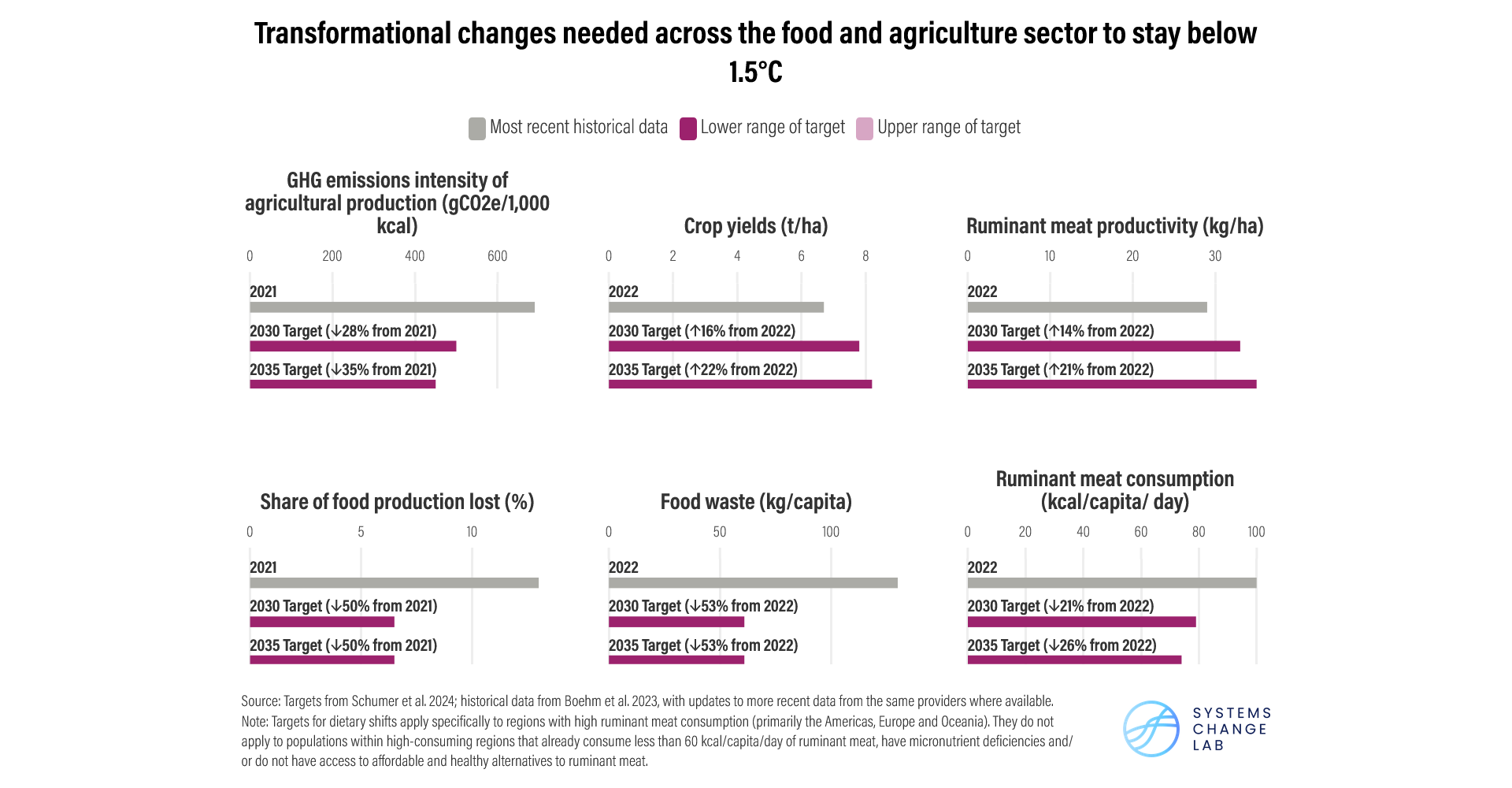
Technological Carbon Dioxide Removal
Alongside deep and rapid emissions cuts across all sectors, pathways that limit warming to 1.5 degrees C all rely on carbon dioxide removal. More specifically, solutions that remove carbon dioxide directly from the air will be needed to reach net-zero emissions and eventually net-negative emissions. Balancing the tradeoffs associated with different carbon removal approaches will require a diverse portfolio of technologies, like direct air capture and carbon mineralization, as well as land-based measures like reforestation.
Today’s estimates show that all technological carbon removal approaches remove and store less than 1 MtCO2 per year, or less than 1% of what will be needed in 2030. The next round of NDCs provides an opportunity for countries that have capacity and/or have already expressed interest in using carbon removal to communicate plans for developing these technologies. Nations should be transparent by considering separate targets for emissions reductions and removals, what carbon removal approaches they will deploy, and how they will establish policy, governance and financing mechanisms to nurture the growing carbon removal industry and ensure its responsible development.
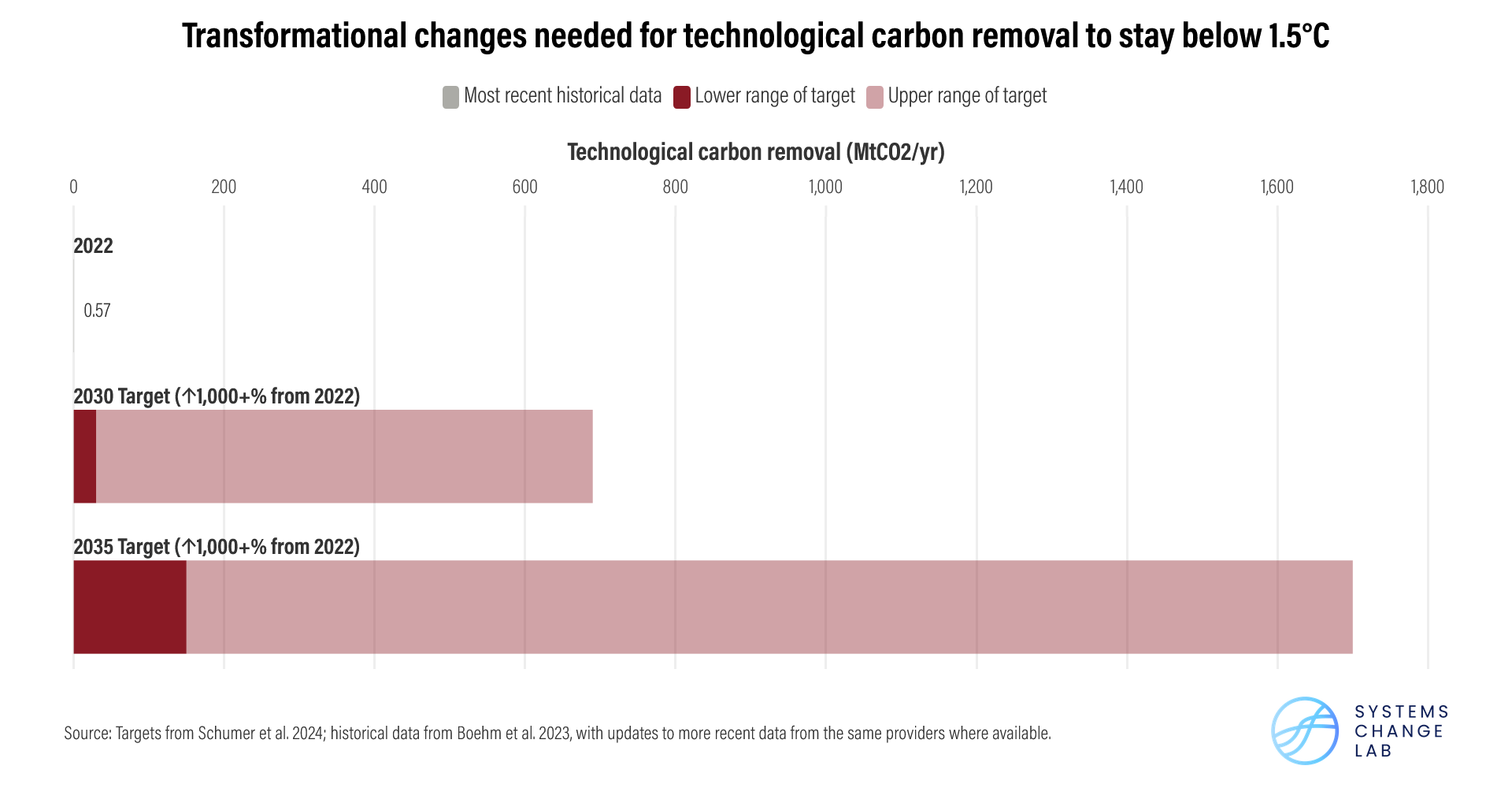
Moving from Rhetoric to Reality
As the deadline to submit their new NDCs approaches, countries are grappling with how they will transform their economies to drastically cut emissions and meet development goals — and on what timeframe.
By communicating ambitious, timebound and sector-specific targets within their forthcoming national climate commitments, countries can demonstrate to the world how they will approach this fundamental challenge. Now is the time to seize the opportunities present in every sector of the economy. Time is pressing, and the stakes couldn’t be higher.
About Systems Change Lab
This article is part of Systems Change Lab, a collaborative initiative — which includes an open-sourced data platform — that is designed to spur action at the pace and scale needed to limit global warming to 1.5 degrees C, halt biodiversity loss and build a just and equitable economy. This article is cross-posted here, on the Systems Change Lab website and on the WRI website.




